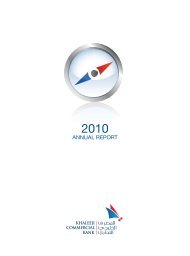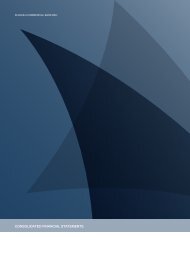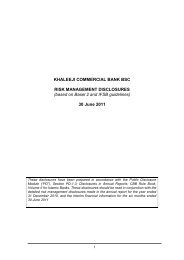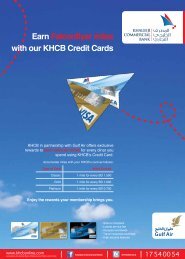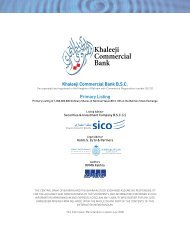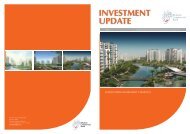2011 Annual Report - Khaleeji Commercial Bank BSC
2011 Annual Report - Khaleeji Commercial Bank BSC
2011 Annual Report - Khaleeji Commercial Bank BSC
You also want an ePaper? Increase the reach of your titles
YUMPU automatically turns print PDFs into web optimized ePapers that Google loves.
KHALEEJI COMMERCIAL BANK <strong>BSC</strong><br />
RISK MANAGEMENT DISCLOSURES<br />
8. Product Disclosures (continued)<br />
8.1 Product descriptions & consumer awareness (continued)<br />
Information on new products or any change in existing products will be placed on the <strong>Bank</strong>’s website www.khcbonline.com<br />
and/or published in the media. Product details are also shared with customers and the general public through brochures and/<br />
or, advertisements.<br />
8.2 Complaint handling<br />
The <strong>Bank</strong> takes disputes and complaints from all customers very seriously. These have the potential for a breakdown in<br />
relationships and can adversely affect the <strong>Bank</strong>’s reputation. Left unattended these can also lead to litigation and possible<br />
censure by the regulatory authorities. The <strong>Bank</strong> has a comprehensive policy on handling of external complaints, approved by<br />
the Board. All employees of the <strong>Bank</strong> are aware of and abide by this policy.<br />
The <strong>Bank</strong> has a designated nodal officer for handling of all external complaints and his contact details are displayed on the<br />
website and also at the Branch and in all printed publicity materials. Complaints are normally investigated by persons not<br />
directly related to the subject matter of the complaint. The <strong>Bank</strong> endeavors to address all complaints within five working days.<br />
Wherever this is not possible, the customer is contacted directly and a time frame for rectification of his complaint advised.<br />
A periodical report on status of complaints is also submitted to the Board.<br />
8.3 Equity of investment account holders (IAH’s)<br />
The <strong>Bank</strong> accepts funds in the form of Mudaraba from small investors and high net worth individuals. Equity of investment<br />
account holders (“IAH”) represents funds offered by customers to the <strong>Bank</strong> to be invested in a Shari’a compliant manner, at<br />
the <strong>Bank</strong>’s discretion as Mudarib. All IAH accounts are on profit sharing basis, but the <strong>Bank</strong> does not guarantee any particular<br />
level of return. Any loss arising from the investment will be borne by the customer except in the case of the <strong>Bank</strong>’s negligence.<br />
The <strong>Bank</strong> charges a Mudarib fee as its share of profit.<br />
The <strong>Bank</strong> accepts IAH funds in Bahraini Dinar, US Dollar and Euro for maturity periods ranging from 1 month to 12 months.<br />
The <strong>Bank</strong> completes its full range of KYC due diligence prior to accepting any investment. The customer also signs a written<br />
agreement covering all terms and conditions of the investment including tenor, basis of profit allocation, early withdrawal, etc.<br />
In 2009, <strong>Bank</strong> has launched a savings account product called “Al-Waffer” which entitles the investors to certain cash prizes,<br />
decided based on a raffle draws held on monthly, quarterly and annual basis apart from the normal share of profits declared<br />
and distributed after reducing the Mudarib fees.<br />
IAH is a significant funding source for the <strong>Bank</strong>. However, the failure to pay the expected return to IAH holders exposes<br />
the <strong>Bank</strong> to displaced commercial risk leading to loss of reputation and business. The <strong>Bank</strong> regularly monitors rate of return<br />
offered by competitors to evaluate the expectations of its Investment Account Holders. <strong>Bank</strong>’s policy also provides for whole<br />
or partial waiver of the Mudarib share of income from investments due to it, to provide a reasonable return to its investors.<br />
<strong>Bank</strong> further mitigates this risk by setting up and maintaining an appropriate level of Profit Equalisation Reserve (“PER”) and<br />
Investment Risk Reserve (“IRR”) to smoothen return to IAH holders.<br />
The <strong>Bank</strong> comingles its own funds and IAH funds which are invested together. The <strong>Bank</strong> has an identified pool of assets where<br />
the IAH funds are invested and the income from which is allocated to such accounts. Out of the gross income the investor’s<br />
share is computed after deducting the Mudarib share and contribution to PER and IRR. The profit allocation schedule signed<br />
by the customer prior to investment contains the scheme of allocation of the Mudarib share and reserves. Administrative<br />
expenses incurred for management of the funds are borne directly by the <strong>Bank</strong> and are not charged separately to investment<br />
accounts. <strong>Bank</strong> has allocated impairment losses on its credit portfolio to the investors; (i.e. assets financed by IAH funds).<br />
During the year, such allocation was absorbed by utilisation of the Profit Equalisation Reserve.<br />
Equity of IAH’s are carried at their book values and include amounts retained towards PER and IRR. Creation of these<br />
reserves results in an increase in the liability towards the pool of IAHs.<br />
Risk Management Disclosures<br />
99



